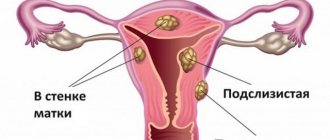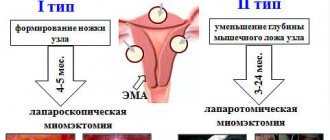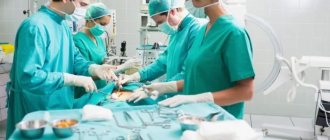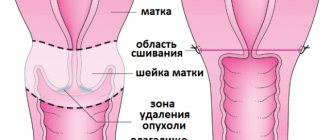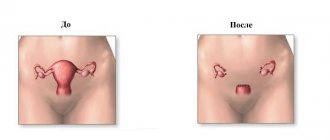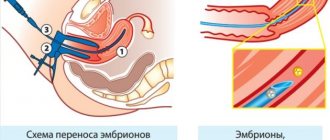When does cycle restoration occur?
The operation is indicated for large tumors. It is also carried out in case of severe symptoms. It can be carried out in various ways - laparoscopically, by the abdominal method, etc. In addition, the body prepares for quite a long time for the operation by taking hormones. Therefore, it is considered normal that menstruation does not begin for some time after myomectomy.
Laparoscopic removal of fibroids
But the course of hormones is designed in such a way that restoration of the cycle occurs as quickly as possible. Therefore, with normal recovery, menstruation can begin no later than 35-40 days after the operation. In this case, the cycle becomes normal almost immediately. Its duration may change by several days compared to what it was before. However, in general there is no fluctuation.
Normal course
A stable and normally occurring menstrual cycle is an important indicator of a woman’s health. Especially when it comes to restoring the body after surgery on the reproductive system. Therefore, it is important to monitor the features of how menstruation occurs after myomectomy. Signs of a normal course are as follows:
- The appearance of menstruation 10-40 days after surgery;
- Discharge of normal volume;
- Normal consistency of discharge (although in the first menstruation it may be denser).
There is one peculiarity. If hysteroscopic myomectomy was performed, then most likely there was mechanical trauma to the organs. Therefore, after such a procedure, a delay in menstruation is natural. But if it is present, you should still consult a doctor to prescribe therapy.
Minor deviations may be due to weakened immunity. They can also be caused by colds, viral or infectious diseases. As well as inflammatory processes in other systems.
Deviations from the norm do not always indicate pathology specifically from the reproductive system.
Not normal flow
It is important to know which signs are not considered normal. If you find them, you should contact your doctor:
- The onset of menstruation is too early - in the first days after surgery. This may be a sign of uterine bleeding;
- Absence of menstruation 40 days after surgery;
- Liquid discharge. They may also be a sign of uterine bleeding, especially in the first two weeks after surgery;
- Too much or too little discharge;
- Significant delays or, conversely, increased periods. Cycle instability. Delay is considered normal only after hysteroscopic myomectomy. In this case, mechanical damage to organs occurs.
Many of these symptoms are not signs of pathological changes. With weak immunity and immunodeficiency conditions, menstruation after removal of fibroids may be unstable. If they differ from normal, it is recommended to consult a doctor to prescribe treatment.
How to get rid of uterine fibroids
There are several main ways to remove uterine fibroids:
- myomectomy;
- uterine artery embolization (UAE);
- hysterectomy.
Each method is applicable in each individual case. As a rule, doctors try to avoid surgery and get rid of fibroids using a conservative method or the UAE method. These therapies are most often prescribed to women for whom the preservation of reproductive function will subsequently be important, since the chances of bearing and giving birth to a child after UAE are much higher than after myomectomy. Mandatory factors for choosing conservative treatment or UAE are light, constant menstruation, small tumor size and absence of pelvic pain. You can read more about new methods of treating uterine fibroids on this page.
Lack of menstruation
In some cases, after such an intervention there are no periods at all. This is an extremely rare case. This usually occurs as a result of anesthesia or stress from the operation. Much less often, this phenomenon is a consequence of problems in the reproductive system.
However, if such a phenomenon occurs, it is necessary to consult a specialist. Usually, a number of studies are prescribed. This includes an ultrasound and a blood test for hormones. At the discretion of the doctor, other studies may be necessary.
Uterus removal
After removal of the fibroids and uterus, menstruation should stop. Sometimes this doesn't happen right away. In some cases, minor bleeding may be present for a few days. It stops on its own and quickly enough. If this does not happen, then you need to contact a specialist.
Bleeding after a hysterectomy can be a serious symptom. Sometimes it indicates a poorly performed operation. Sometimes it’s about a poor healing process or the addition of pathologies.
Myomectomy or UAE
If a patient has a choice between a myomectomy or uterine artery embolization, it is worth considering very carefully. Each method is a reliable way to remove uterine fibroids, but both have their own advantages and disadvantages.
The advantages of EMA include:
- minimal risk of postoperative complications. The literature describes that less than 1% of women who undergo uterine artery embolization have complications or residual problems with uterine fibroids. This makes the method the most reliable of all existing ones, as it reduces all risks of complications to zero;
- minor trauma during manipulation. This is due to the fact that UAE is carried out by introducing special embolization particles through a catheter into the area of the inguinal fold, which close and stop the blood flow in myomatous tumors. To do this, only one puncture is made next to the femoral artery;
- preservation of menstrual and reproductive function and a greater likelihood of becoming pregnant in the future. The first periods after UAE may begin much earlier than expected, have a character different from usual (more abundant, spotting, with long intervals, painful or may not be felt at all), but over time the cycle is restored. It is believed that the likelihood of conceiving and carrying a child to term is much higher after UAE than after any other surgical intervention, since any operation entails the formation of adhesions, which can complicate pregnancy;
- carrying out rehabilitation as soon as possible. Recovery after endovascular treatment takes from 5 to 14 days. For the first two days, the woman is in the hospital under the supervision of doctors, after which she can return home;
- relief from pain and symptoms of fibroids. In the first couple of days immediately after UAE, there may be slight bleeding and tingling pain in the pelvic area. Minor pain during the injection of the drug into the artery is also considered normal.
Heavy discharge
The size of fibroids can reach the size of a pregnant woman’s uterus. According to statistics, heavy periods are observed 12 weeks after the appearance of fibroids. However, heavy periods often appear when the first myomatous nodes form.
A woman may experience significant blood loss for several reasons:
- previous surgery (abortion, curettage);
- tumor growth, causing it to compress nearby organs and tissues;
- with submucosal localization of the neoplasm, menstruation occurs intensively and for a long time
Violation of regularity
Hormonal changes lead to disruption of the menstrual cycle, and menstruation with fibroids takes on an unnatural characteristic. In addition to the instability of menstruation, the woman experiences severe pain.
Uterine fibroids affect the regularity of menstruation, so a woman may experience menstruation twice a month.
Hormonal fluctuations provoke the development of the endometrium, which is why rejection occurs more often than usual. Delay with fibroids is extremely rare.
If a woman has not had her period for a long period and suddenly has heavy bleeding, she should definitely consult a gynecologist.
Fibroids do not prevent conception - if a woman becomes pregnant, she may experience a delay. The tumor interferes with pregnancy and can cause miscarriage. By purchasing a test at a pharmacy, a woman will know for sure about pregnancy.
Signs of uterine fibroids
Symptoms of fibroids in the initial stage may be mild or completely absent, but if the patient has been bothered by one or more of the following symptoms for a long time, she should immediately consult a doctor.
Possible symptoms of uterine fibroids:
- increased urge to urinate;
- difficulty defecating (constipation);
- heavy menstruation with blood clots, foul odor, or pus;
- long and painful periods;
- bloating;
- heaviness in the stomach;
- pain during sexual intercourse;
- increased flatulence;
- bloody (spotting or heavy) discharge before or after menstruation;
- cramps in the lower abdomen;
- pain in the lower back and spine;
- miscarriages;
- infertility;
- anemia;
- general weakness and drowsiness;
- disrupted menstrual cycle.
Soreness
Most women who have fibroids complain of pain. Most often, pain appears if the neoplasm is localized in the intermuscular space and develops towards the uterine cavity. Menstruation in such a situation is long, heavy, and pain disappears only after the cessation of menstruation.
The same symptoms can be found with submucosal tumor localization. However, in this case, the pain is cramping in nature, which is caused by the pressure of the neoplasm on the nearest organs. This condition is accompanied by frequent urge to go to the toilet, flatulence, and pain.
Menstruation after fibroid surgery
The topic remains quite relevant among women: how long does it take to get your period after fibroid removal? This is not surprising, because with the rapid development of a tumor, drug treatment does not help, and if a woman has no contraindications, doctors prescribe surgical intervention. Various factors influence the operation, for example, in emergency cases to remove the uterus, menstruation is not paid attention to. In other cases, surgical treatment occurs as planned, on days when menstruation does not occur.
Modern surgical techniques make it possible to perform surgery without removing or significantly damaging organs. Therefore, a woman, even after surgery, can become pregnant and give birth to a child.
Menstruation after removal of uterine fibroids occurs within two months. The timing of their resumption is influenced by the location of the tumor, the process of tissue regeneration, and the type of formation. For some time, a woman will feel pain during menstruation, but it does not exceed a critical level.
To speed up the recovery process, it is recommended to avoid excessive physical activity for at least six months. Also, in the first three months it is better to refrain from intimacy and completely give up bad habits.
After surgical treatment, a woman may experience heavy discharge. This condition occurs for the following reasons:
- removal of a large tumor, so after surgery the uterine muscles are too weak;
- relapse;
- injury to nearby organs.
If this condition is accompanied by the appearance of other negative symptoms (nausea, pain, urination with blood, fever), you must consult your doctor.
Types of Uterine Fibroids
Before proceeding to direct treatment of a myomatous tumor, it is necessary to first identify its type. Scientists distinguish three main types of fibroids:
- Subserous. Such nodes are localized under the outer lining of the uterine walls and grow outward, giving the uterus itself a nodular shape. It is characterized by pain in the pelvis and sacrum, disorders of the bowel, bladder and pelvic vessels, but, as a rule, does not interfere with the timely onset of menstruation. Such a neoplasm is not felt until it is small in size and does not put pressure on neighboring organs. The subserous node can be located on a stalk, which makes it look very similar to the ovary. Such myomatous formations are called pendular. For an accurate diagnosis, a woman with suspected subserous myoma is recommended to undergo ultrasound, tomography and magnetic resonance imaging.
- Interstitial (intramural). It is the most common type of fibroids in women. It is located on the walls of the uterus and rapidly grows inward, increasing its size. This type of myomatous node can be diagnosed using an internal gynecological examination. Intramural nodes are characterized by pain in the pelvic area, spine, heavy uterine bleeding, and a feeling of pressure on neighboring organs.
- Submucosal. Develops under the mucous membrane of the uterine cavity. It is the least common type, but the most dangerous, since even one submucous node can cause very serious and life-threatening uterine bleeding.
How to stop bleeding
If a woman experiences intense menstruation, she should visit a gynecologist. The doctor will conduct an examination that will help determine the nature of the discharge and prescribe adequate methods of therapy. Self-medication can provoke complications, which will require surgical treatment.
Medicines
To normalize the condition, hormonal drugs are usually prescribed. Treatment is aimed at suppressing gonadotropins, which should reduce the size of the genitals, stopping bleeding.
Most often, the doctor prescribes Duphaston, Norkolut. These medications suppress the activity of sex hormones, normalize the menstrual cycle, and sometimes help cure neoplasms.
Tranexam increases blood clotting and enhances platelet production. Ascorutin helps strengthen the walls of blood vessels. Dicynone strengthens capillaries, protecting against fragility. The patient may also be prescribed Vikasol, Etamzilat. The choice of medications depends on individual characteristics, so selecting medications without consulting a doctor is not recommended.
Traditional treatment
There are a huge number of folk recipes based on medicinal herbs that help normalize the condition of heavy menstruation. The most effective are:
- Combine shepherd's purse, nettle, and knotweed in equal proportions. 2 tbsp. l. Pour boiling water over the resulting mixture, leave for 10 minutes, strain. Drink 3 times a day, 0.5 cups. Treatment begins three days before the critical days and ends with them.
- Combine raspberry and mint leaves in equal proportions. Pour boiling water over the mixture and leave for about 15 minutes. Mix sugar and viburnum until smooth, add the mixture to the drink. Take instead of regular tea at any time of the day.
- Pour 1 tbsp. l. corn silk with a glass of boiling water, leave for 30 minutes. Use 1 tbsp every three hours. l.
Features of myomectomy
Myomectomy is a surgical treatment of myomatous nodes that preserves the uterus and its basic functions.
Indications for myomectomy:
- Pregnancy planning. If a woman does not have children at the time of her illness, but plans to have them in the future, doctors opt for myomectomy or UAE, since these interventions involve preserving the functions of the reproductive organ in the future. Planning pregnancy is allowed six months after surgery.
- The patient's age is less than 50 years. As a rule, for women of this age, doctors do not consider performing a myomectomy, since preserving the uterus and its functionality is no longer in the first place. In such cases, it is possible to remove the uterus along with its appendages.
- Location of myomatous nodes. The easiest to remove are small nodes on a “pedicle”, which are localized on the outer wall of the uterus or in its cavity.
However, if a woman wishes to maintain menstrual function in the future without planning a pregnancy, taking into account all the risks and contraindications, the doctor can perform a myomectomy with the written permission of the woman herself.
Surgical practice offers myomectomy in three different ways:
- Laparoscopic. The most common, gentle and least traumatic type of myomectomy, which is performed using a specialized optical instrument - a laparoscope through small punctures in the body. However, the disadvantage of this method is that it can only be applied to subserous and intramural fibroids.
- Abdominal. This method is more traumatic than myomectomy or UAE, as it is performed through an incision in the suprapubic abdomen by removing myomatous nodes in the area of healthy tissue.
- Hysteroscopic. In this case, the removal of myomatous formations takes place through the vagina. This method is also diagnostic when examining fibroids located inside the uterine cavity. The risk of complications, compared to other methods, when performing such surgical intervention is minimal.
